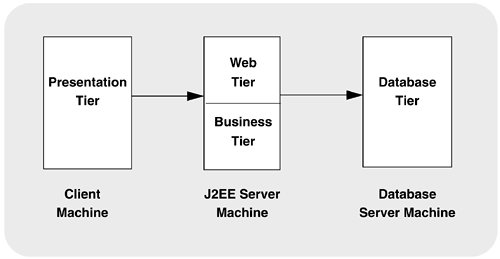J2EE Architecture
By: aathishankaran in Java Tutorials on 2007-02-20
The required relationships of architectural elements of the J2EE platform are shown in Figure below. Note that this shows the logical relationships of the elements; it is not meant to imply a physical partitioning of the elements into separate machines, processes, address spaces, or virtual machines.
The Containers, denoted by the separate rectangles, are J2EE runtime environments that provide required services to the application components represented in the upper half of the rectangle. The boxes in the lower half of the rectangle denote the services provided.
For example, the Application Client Container provides Java Message Service (JMS) APIs to Application Clients, as well as the other services represented. All these services are explained below. The arrows represent required access to other parts of the J2EE platform.
The Application Client Container provides Application Clients with direct access to the J2EE required Database through the Java API for connectivity with database systems, the JDBCTM API. The EJB Container provides similar access to databases to JSP pages and servlets by the Web Container, and to enterprise beans. As indicated the APIs of the JavaTM 2 Platform, Standard Edition (J2SETM), are supported by J2SE runtime environments for each type of application component.

Add Comment
This policy contains information about your privacy. By posting, you are declaring that you understand this policy:
- Your name, rating, website address, town, country, state and comment will be publicly displayed if entered.
- Aside from the data entered into these form fields, other stored data about your comment will include:
- Your IP address (not displayed)
- The time/date of your submission (displayed)
- Your email address will not be shared. It is collected for only two reasons:
- Administrative purposes, should a need to contact you arise.
- To inform you of new comments, should you subscribe to receive notifications.
- A cookie may be set on your computer. This is used to remember your inputs. It will expire by itself.
This policy is subject to change at any time and without notice.
These terms and conditions contain rules about posting comments. By submitting a comment, you are declaring that you agree with these rules:
- Although the administrator will attempt to moderate comments, it is impossible for every comment to have been moderated at any given time.
- You acknowledge that all comments express the views and opinions of the original author and not those of the administrator.
- You agree not to post any material which is knowingly false, obscene, hateful, threatening, harassing or invasive of a person's privacy.
- The administrator has the right to edit, move or remove any comment for any reason and without notice.
Failure to comply with these rules may result in being banned from submitting further comments.
These terms and conditions are subject to change at any time and without notice.
- Data Science
- Android
- React Native
- AJAX
- ASP.net
- C
- C++
- C#
- Cocoa
- Cloud Computing
- HTML5
- Java
- Javascript
- JSF
- JSP
- J2ME
- Java Beans
- EJB
- JDBC
- Linux
- Mac OS X
- iPhone
- MySQL
- Office 365
- Perl
- PHP
- Python
- Ruby
- VB.net
- Hibernate
- Struts
- SAP
- Trends
- Tech Reviews
- WebServices
- XML
- Certification
- Interview
categories
Related Tutorials
Read a file having a list of telnet commands and execute them one by one using Java
Open a .docx file and show content in a TextArea using Java
Step by Step guide to setup freetts for Java
Of Object, equals (), == and hashCode ()
Using the AWS SDK for Java in Eclipse
DateFormat sample program in Java
concurrent.Flow instead of Observable class in Java
Calculator application in Java
Sending Email from Java application (using gmail)
Comments